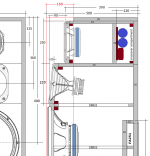Well, when I tested the Scan Speak 10 F for the first time, last year, I was astonished by the bass it produced. It must have been less than 1 W. It's presented as a full range, and it does the job. I use it as a midrange for power over 1 W, with 47 uF HP & 0.5 mH LP.
But that doesn't mean much. It's how the system is configured
But that doesn't mean much. It's how the system is configured
Getting older her too. Loud can be fun for a short time. But actually I never found loud sounds nice, like from pneumatics, hammering on stuff or the rough sound from a shovel in gravel to the much to often illegal exhaust on these summer-motorcyclist driving down narrow city roads - twisting their throttle-wrist every 300 m or so with the clutch engaged on their middle-aged panic investment. Sorry for my small rant there - but I actually like to hear birds singing and wind in the trees 😀
But with speakers that have good smooth dispersion and deep well controlled bass - like with multi-sub, I actually still enjoy the dynamics of electronics music like Trentemolle, Massive Attack, Yello and others. It might not get super loud, but it still plays great at lower levels, and I also appreciate the higher level of details too in these types of music. So still the same by heart, just better quality sound, a little lower - and older 😀
I do agree and always think that it's how a system plays softer notes that defines how good it is, (maybe the ear can differentiate them rather than being swamped). But yesterday whilst listening to Fun Lovin Criminals "Come find yourself" through Micro Utopia's decided to crank up the level. The way the sound then gelled into a more amorphous whole was an eye opener. (And ear!)
PS.
The reason for the inset drivers is to "point" the driver toward the focus. (It's not easy to see on the picture but all the front facing drivers are angled differently. If these insets are a disadvantage I will consider a redesign to remove them.
They are a huge disadvantage, as they will produce measurable interference issues.
Agreed.... this will absolutely not help. Put them straight in the front like AR9 or the like.They are a huge disadvantage, as they will produce measurable interference issues.

An externally hosted image should be here but it was not working when we last tested it.
And strongly consider making it active, so that you can easily tune and delay the tweeter according to the midrange. And powering the woofer with no passive cross-over is a really good thing to - and way easier 🙂
If you should consider pointing the drivers... at least do it like Troels G does it:
The-Loudspeaker-III
And make it active .... the bass as a minimum 🙂
The-Loudspeaker-III
And make it active .... the bass as a minimum 🙂
digitalthor,
From the perspective of wavefront assimilation, pointing a waveguide inward like in the link is a compromise. Actually it's the spacing which is the essence of the compromise, however pointing them away from each other should be explored during design time. Often pointing straight ahead isn't the worst thing you can do.
From the perspective of wavefront assimilation, pointing a waveguide inward like in the link is a compromise. Actually it's the spacing which is the essence of the compromise, however pointing them away from each other should be explored during design time. Often pointing straight ahead isn't the worst thing you can do.
Components between the amp and woofer shouldn't be causing a problem.powering the woofer with no passive cross-over is a really good thing
Attachments
Due to the advice received here, (Thanks to all) I am changing the driver mounting, to have internal chamfers that do not cross from one driver box to another. (in a way similar to Wesayso's examples) Like very short horns (<10 mm or so). It's starting to look a bit JMLabs Utopia-ish (which I didn't really want, but, oh well!) I'm not in favour of active speakers with all the extra electronics that entails, I may be 'biased' but it seems contrary to simple amp stages etc and after hearing the difference that single capacitor change has, I don't favour introducing 20 to 30 extra of them. My initial preference will be for lower order XO's if possible and I will even accept a little 'peekyness' in the FR to maintain the 'soul' of the sound and reduce phase changes etc (aims I know).
Best R
Best R
JonBocani, It's just occurred to me that I/we may have hijacked your thread, sorry for that I do hope that you don't mind. In some small way as an excuse I will say that I intend to use PHL 1120 midrange drivers. These were designed by the same person who designed the Audax AP170M0 so they should be good. Those were said to be "World class midrange drivers" So, I rest my case!
🙂
🙂
I might have been too quick on the keyboard. I was merely advocating an active bass system and straight front 🙂digitalthor,
From the perspective of wavefront assimilation, pointing a waveguide inward like in the link is a compromise. Actually it's the spacing which is the essence of the compromise, however pointing them away from each other should be explored during design time. Often pointing straight ahead isn't the worst thing you can do.
Components between the amp and woofer shouldn't be causing a problem.
- Home
- Loudspeakers
- Multi-Way
- World's Best Midranges - Shocking Results & Conclusions.
